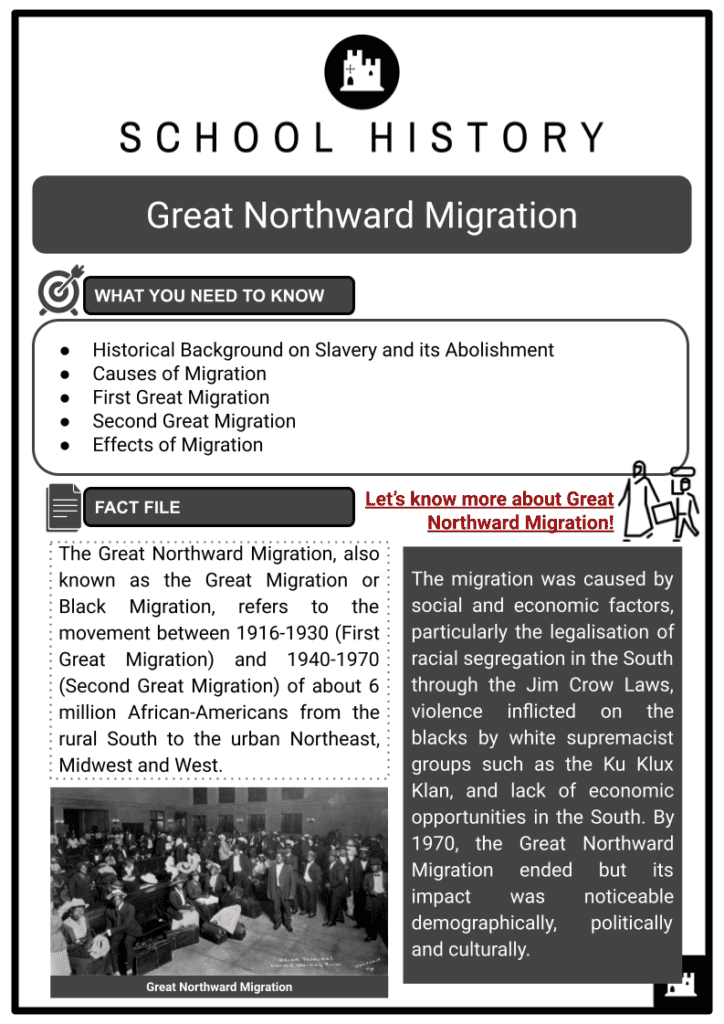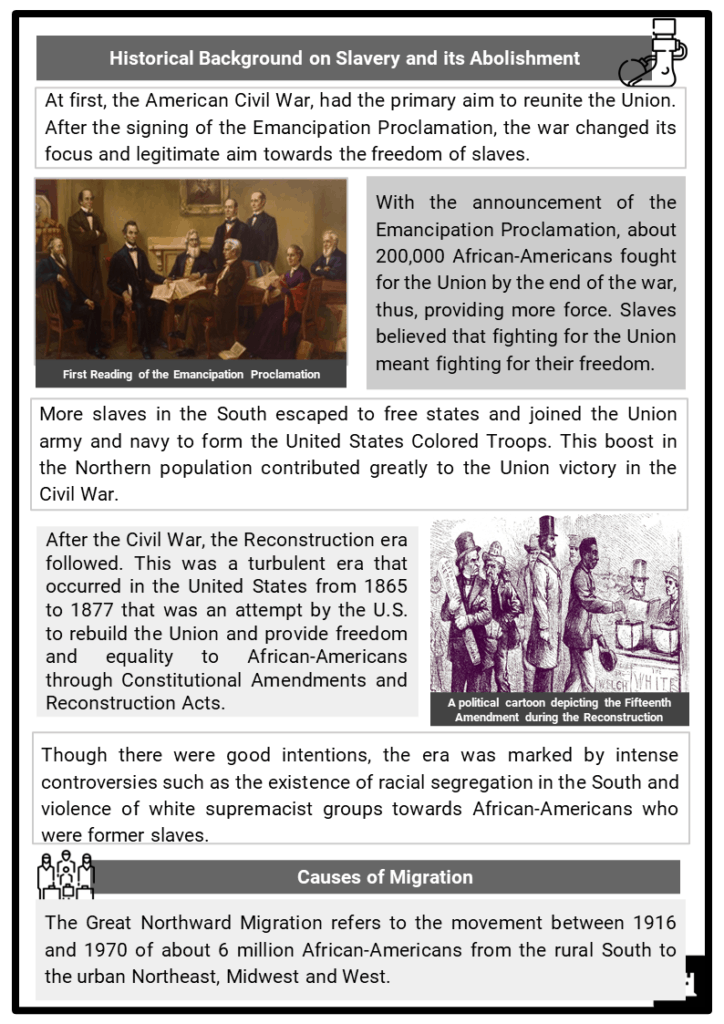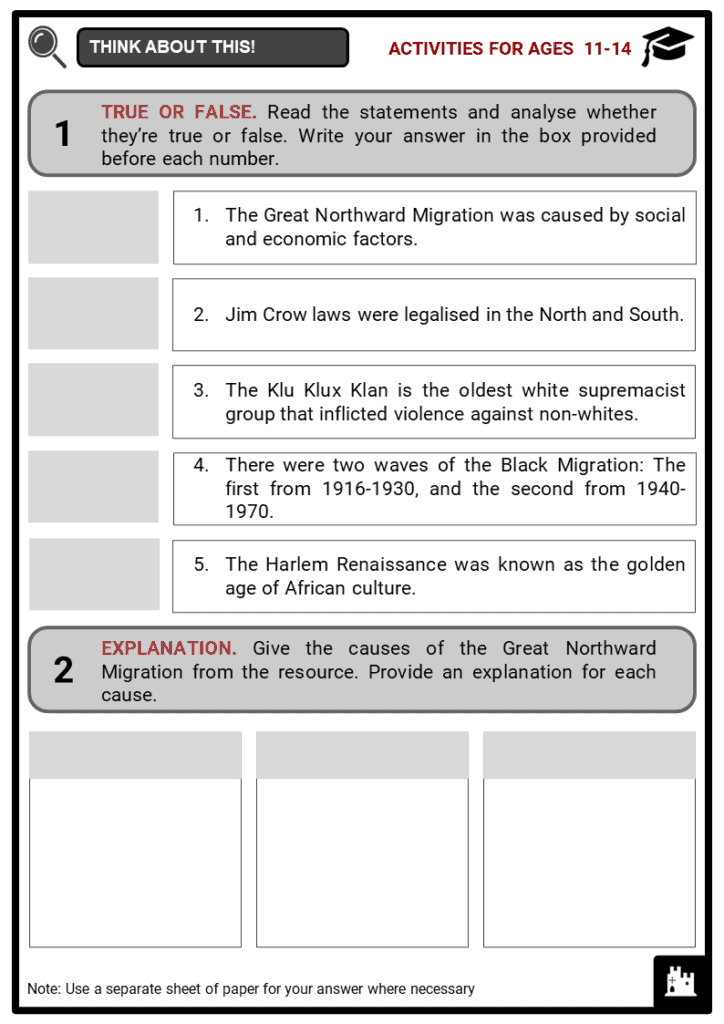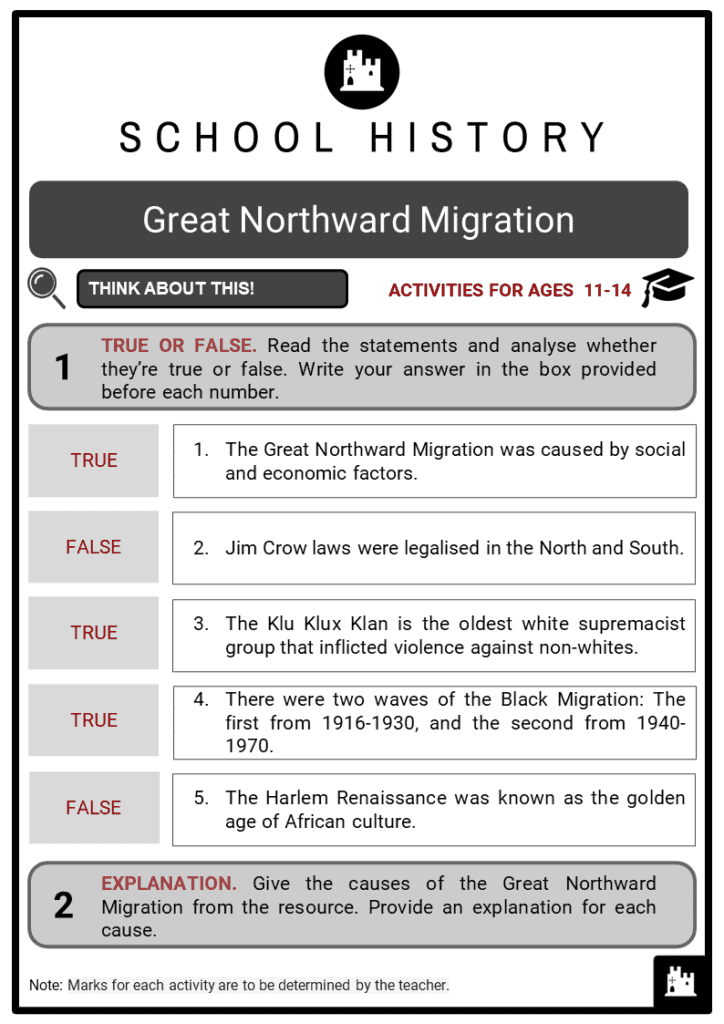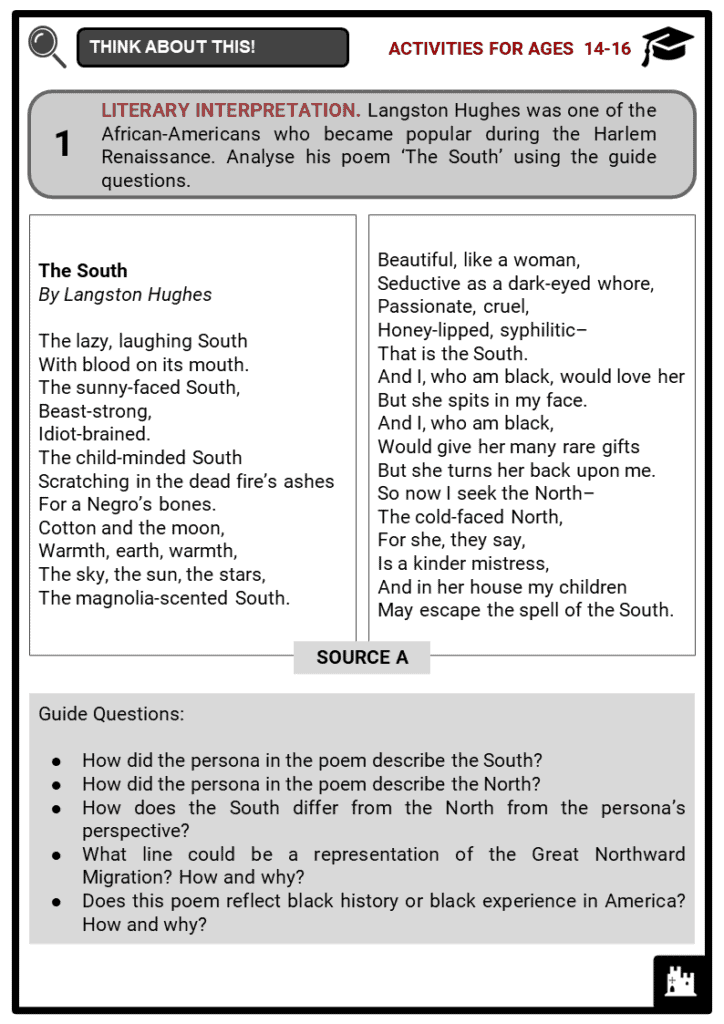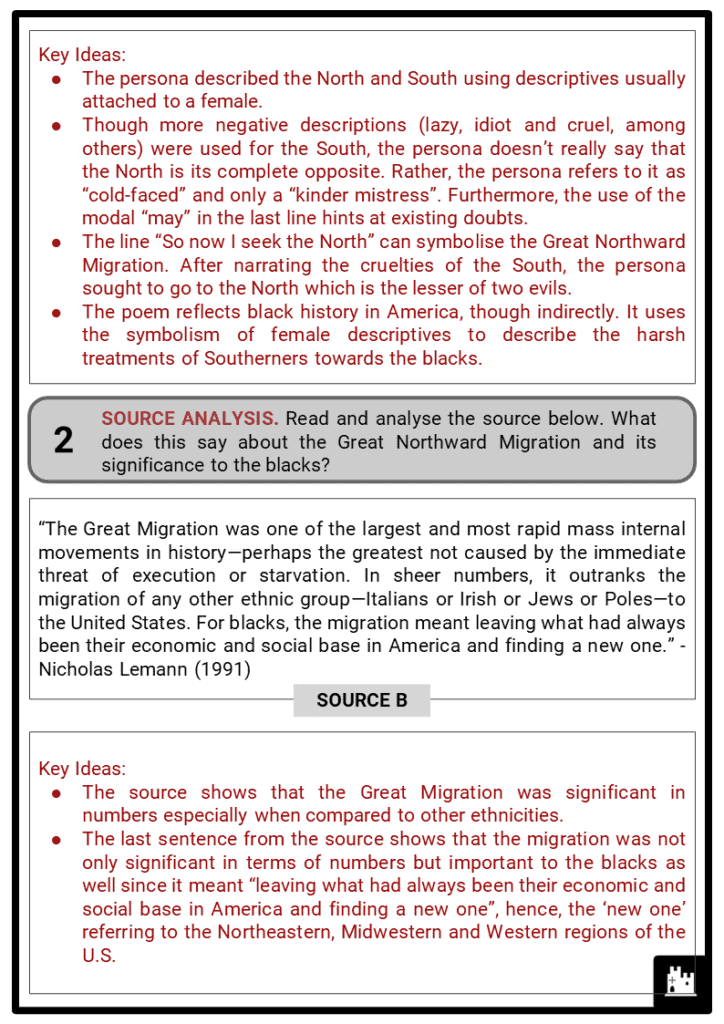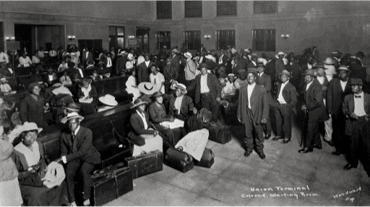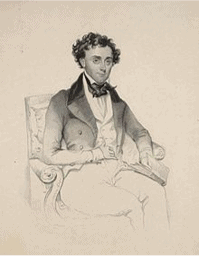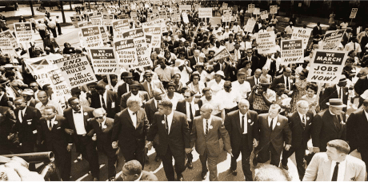Download Great Northward Migration Worksheets
Do you want to save dozens of hours in time? Get your evenings and weekends back? Be able to teach Great Northward Migration to your students?
Our worksheet bundle includes a fact file and printable worksheets and student activities. Perfect for both the classroom and homeschooling!
Table of Contents
Add a header to begin generating the table of contents
Summary
- Historical Background on Slavery and its Abolishment
- Causes of Migration
- First Great Migration
- Second Great Migration
- Effects of Migration
Key Facts And Information
Let’s know more about the Great Northward Migration!
- The Great Northward Migration, also known as the Great Migration or Black Migration, refers to the movement between 1916-1930 (First Great Migration) and 1940-1970 (Second Great Migration) of about 6 million African-Americans from the rural South to the urban Northeast, Midwest and West.
- The migration was caused by social and economic factors, particularly the legalisation of racial segregation in the South through the Jim Crow Laws, violence inflicted on the blacks by white supremacist groups such as the Ku Klux Klan, and lack of economic opportunities in the South. By 1970, the Great Northward Migration ended but its impact was noticeable demographically, politically and culturally.
Historical Background on Slavery and its Abolishment
- At first, the American Civil War, had the primary aim to reunite the Union. After the signing of the Emancipation Proclamation, the war changed its focus and legitimate aim towards the freedom of enslaved people.
- With the announcement of the Emancipation Proclamation, about 200,000 African-Americans fought for the Union by the end of the war, thus, providing more force. Enslaved people believed that fighting for the Union meant fighting for their freedom.
- More enslaved people in the South escaped to free states and joined the Union army and navy to form the United States Colored Troops. This boost in the Northern population contributed greatly to the Union victory in the Civil War.
- After the Civil War, the Reconstruction era followed. This was a turbulent era that occurred in the United States from 1865 to 1877 that was an attempt by the U.S. to rebuild the Union and provide freedom and equality to African-Americans through Constitutional Amendments and Reconstruction Acts.
- Though there were good intentions, the era was marked by intense controversies such as the existence of racial segregation in the South and violence of white supremacist groups towards African-Americans who were formerly enslaved.
Causes of Migration
- The Great Northward Migration refers to the movement between 1916 and 1970 of about 6 million African-Americans from the rural South to the urban Northeast, Midwest and West.
- The migration was possible because of the spread of racist ideologies and the lack of economic opportunities in the South for the black community.
- A. Jim Crow Laws
- During the Reconstruction period that aimed to bring back the seceded states and integrate the black population into the United States, white Southern Democrat-dominated state legislatures were created to disenfranchise the blacks.
- The Jim Crow laws refers to the series of laws that legalised racial segregation from the end of the Reconstruction period in 1877 until the enactment of the Voting Rights Act in 1965.
- This series of laws was known for their legal doctrine ‘separate but equal’ that was applied to the facilities made for the blacks. This cemented racial discrimination and favoured white people over black people.
- The name Jim Crow was first used in 1832 by Thomas D. Rice, a white actor performing in blackface makeup to a routine known as ‘Jump Jim Crow’.
-
- Jim Crow was, therefore, a derogatory term for African-Americans.
- To escape the harsh segregation laws in the South, blacks migrated to the Northern and Western parts of the U.S.
- B. White Supremacist Groups
- Aside from black segregation and disenfranchisement, white supremacist groups rose to torment non-whites whom they thought were a threat to the ‘purity’ of their race.
- Probably the oldest and most popular supremacist group is the Ku Klux Klan, also called KKK or Klan, that was founded by Confederate army soldiers led by General Nathan Bedford Forrest in 1866. By 1870, it had spread to most of the Southern states as a resistance mob against Reconstruction policies.
- The Klan was known for being perpetrators of violence. When the Fifteenth Amendment was ratified that granted male suffrage, the Klansmen were in a bid to restore white supremacy.
- They dedicated themselves to undercover violence in the South, against black people and Republican supporters disparaged as scalawags and carpetbaggers. It is estimated that they undertook approximately 3,500 lynches between 1865 and 1900.
- C. Lack of Economic Opportunities
- The lack of social opportunities created by the Jim Crow laws and white supremacist groups may have pushed the African-Americans away from the South, but the lack of economic opportunities also pulled them to the North.
- World War I brought labour shortages in Northern factories which resulted in the opening of thousands of jobs in the field of automobiles, steel mills and railroads, among others.
- This abundance of job opportunities was strengthened by labour agents who were sent by Northern businessmen to recruit Southern workers. Furthermore, some Northern companies offered special incentives like free transportation and low-cost housing that encouraged black workers to relocate to the North.
First Great Migration (1916-1930s)
- Only less than eight percent of the population of African-Americans lived in the North when the Emancipation Proclamation was signed.
- This, however, changed after a decade due to the First Great Migration when the African-American population increased to forty percent as they moved to the Northeast and Midwest.
- Some of the biggest increases were in the cities of New York City (New York), Chicago (Illinois), Cleveland (Ohio), Baltimore (Maryland), Detroit (Canada) and Philadelphia (Pennsylvania) that offered industrial work opportunities.
- The migration northward brought forth increasing racial tensions between the white community and the black community in the workplace. Protests and violence from the whites erupted, advocating segregation from the blacks.
- Aside from competition for employment, the black migrants were also met with conflicts over housing in crowded cities. Although the Jim Crow law wasn’t legalised in the North, racist ideologies were still widespread.
- The pace of black migration accelerated with the outbreak of World War I up till the 1920s. This number reduced, however, during the Great Depression of the 1930s that decreased job opportunities in the North.
Second Great Migration (1940-1970s)
- Though the First Great Migration slowed down during the Great Depression, it picked up again with the coming of World War II, creating a second wave of migration.
- The Second Great Migration saw about five million African-Americans from the South migrate from 1940 until 1970 because of economic opportunities for wartime production.
- During the second wave of migration, African-Americans ventured not only to the North and Midwest but also to the West through cities like Oakland (California), Portland (Oregon), Seattle (Washington), Phoenix (Arizona) and Los Angeles (California) that offered a workforce in the defence industry. By 1970, the Great Northward Migration ended with an apparent demographic, political and cultural impact.
Effects of Migration
- Cultural Impact: Harlem Renaissance
- Results of housing tensions in the North with the arrival of black migrants fostered the growth of a new urban African-American culture, particularly in Harlem, Manhattan, New York City that was formerly an all-white neighbourhood that began to house about 200,000 African-Americans during the migration.
- From here, the Harlem Renaissance – known at that time as the New Negro Movement – was formed to revive African-American art and literature.
- This period, which started roughly around the 1910s and lasted till the mid-1930s, became known as the golden age in African-American culture.
- Political Impact: Civil Rights Movement
- Aside from the cultural impact brought about by the Great Northward Migration, a new era of increasing political activism among African-Americans also began.
- By the middle of the 20th century, African-Americans became tired of succumbing to the racist whites. This resulted in a decades-long organised and unprecedented fight for equality known as the Civil Rights Movement.
- African-Americans sought to end institutionalised racial discrimination, racial segregation, and disenfranchisement in the United States.
- Demographic Impact
- When the Great Northward Migration ended in 1970, its demographic impact was evident.
- In 1900, 9 out of every 10 African-Americans might have resided in the South, but by 1970, the South had only less than half of the country’s African-American population. Furthermore, 3 out of 4 blacks may have lived in rural areas in 1900, but only 25% were left living there by 1970 (History.com, 2020).
Image sources:

